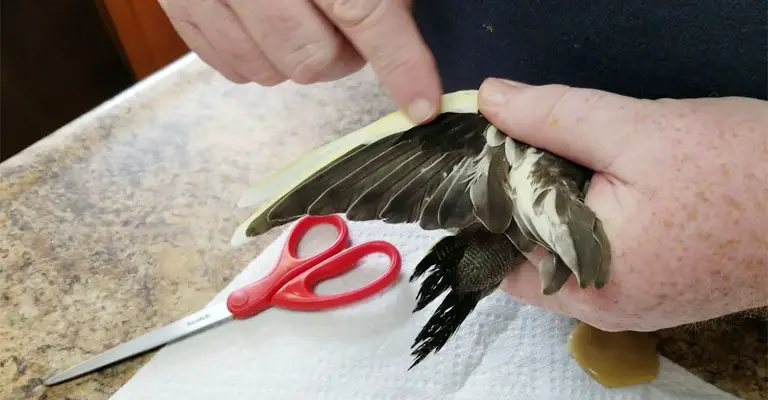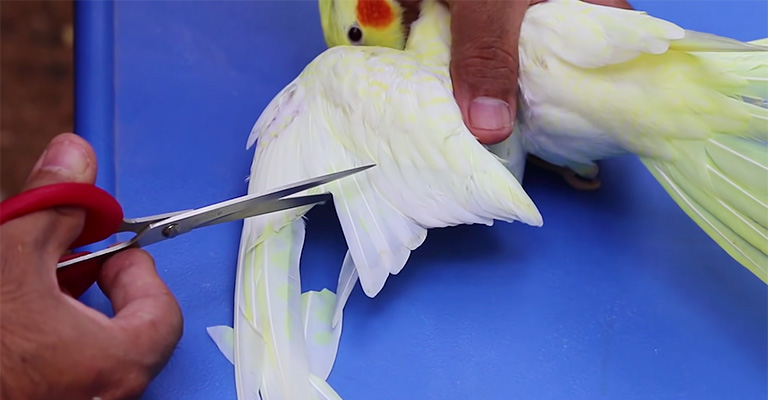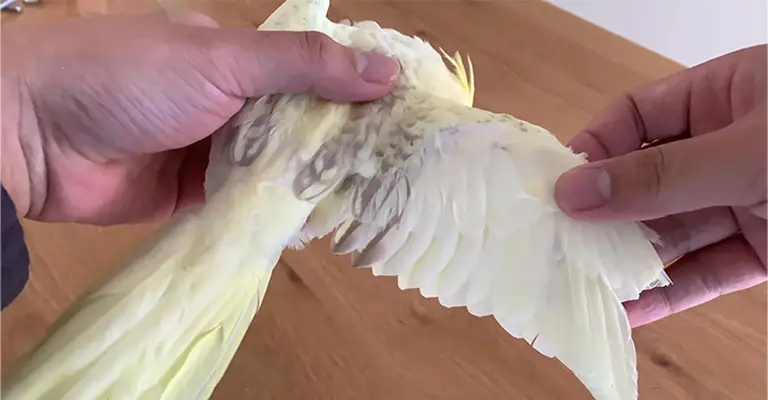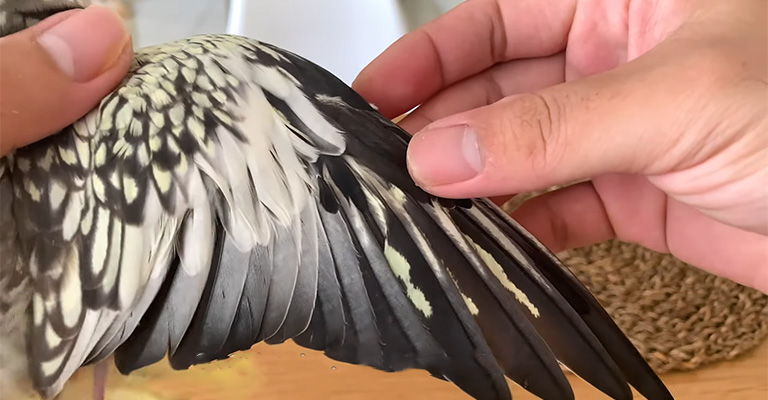Cockatiels, with their charming personalities and striking crests, make delightful companions. However, ensuring their safety within your home is paramount.
One effective method to achieve this is by learning how to clip a cockatiel’s wings properly. In this comprehensive guide, we’ll walk you through the essential steps and considerations on the question ‘How To Clip a Cockatiel Wings?’.
Wing clipping can prevent accidents, promote training, and strengthen the bond between you and your feathered friend. But it’s a delicate procedure that must be done with care and precision.
Whether you’re a new cockatiel owner or seeking a refresher on this essential skill, this guide will provide you with valuable insights and tips. So, stay focused.

When To Clip A Cockatiels Wings?
You should consider clipping a cockatiel’s wings when you want to ensure their safety and prevent them from flying into dangerous situations. This is typically done when the bird is young and still learning to navigate its environment.
It’s essential to consult with an avian veterinarian or an experienced bird groomer to determine the appropriate time for wing clipping, as it depends on the bird’s age and overall health.
Wing clipping is a temporary and reversible procedure that involves trimming some of the flight feathers to limit a bird’s ability to gain altitude and distance in flight. This helps prevent accidents, such as crashing into windows or flying into hazards within your home.
However, it’s crucial to ensure the procedure is done correctly, leaving enough feathers for balance and gliding.
Remember that wing clipping should be a temporary measure, and as your cockatiel gains more experience and confidence, you can allow its feathers to grow back naturally to enable flight
How To Clip A Cockatiels Wings?
Clipping a cockatiel’s wings is a delicate procedure that should ideally be performed by a veterinarian or an experienced bird groomer. However, if you have the necessary knowledge and confidence, you can attempt it at home. Here are the basic steps to safely clip a cockatiel’s wings:
Materials Needed
- Small, sharp scissors or bird-specific wing clippers.
- Styptic powder or cornstarch to stop bleeding if a feather is accidentally cut too short.
- A towel or cloth to gently restrain your cockatiel.
Procedure
- Prepare a quiet, well-lit, and comfortable space for the procedure.
- Approach your cockatiel calmly and gently. If your bird is skittish or not used to being handled, it’s a good idea to practice gentle handling and bonding before attempting wing clipping.
- Cover your bird with a towel, leaving only its wings exposed. This helps to keep your cockatiel calm and still.
- Carefully extend one wing at a time, holding it firmly but gently. You should only clip the primary flight feathers, which are the long feathers at the ends of the wings. Do not cut any other feathers.
- Trim only a small portion of the primary flight feathers, usually about the first 1/3 to 1/2 of each feather. This should be done symmetrically on both wings to maintain balance. Be cautious not to cut too close to the feather shaft, as this can cause pain and bleeding.
- Check each cut carefully to ensure there is no bleeding. If bleeding occurs, use styptic powder or cornstarch to stop it. Apply gentle pressure until the bleeding stops.
- Repeat the process for the other wing, maintaining symmetry.
- After both wings are clipped, carefully return your cockatiel to its cage or a safe, secure space. Observe its behavior to ensure it is adjusting well to the change.
It’s crucial to note that wing clipping should only be a temporary measure for safety purposes. As your cockatiel molts and regrows its feathers, you should allow them to regain their full flight capability.
Post Clipping Care for Cockatiels Wings

After clipping your cockatiel’s wings, it’s essential to provide proper post-clipping care to ensure your pet’s well-being and comfort during the adjustment period. Here are some important steps to follow:
Observe Your Cockatiel
After wing clipping, observe your cockatiel closely to ensure it is adapting well to the reduced flight capability. Watch for any signs of stress or discomfort.
Safe Environment
Keep your cockatiel in a safe and bird-proofed environment. Ensure there are no hazards or obstacles that it could accidentally crash into, such as open windows, mirrors, or ceiling fans.
Additional Perches
Offer additional perches of varying heights and textures within the cage. This helps your cockatiel exercise and maintain its balance. Natural wooden perches are a good choice.
Mental Stimulation
Provide toys and activities to keep your cockatiel mentally and physically engaged. Cockatiels are intelligent birds that need mental stimulation to stay happy and healthy.
Diet and Nutrition
Ensure your cockatiel continues to receive a balanced diet. Fresh fruits, vegetables, pellets, and clean water should be readily available. Consult your veterinarian for specific dietary recommendations.
Gentle Handling
Be extra gentle when handling your cockatiel during the adjustment period. Minimize stressful situations, and handle your bird with care and patience.
Social Interaction
Spend quality time with your cockatiel. Cockatiels are social birds and need interaction and attention from their owners. Engage in bonding activities like talking to them and offering treats.
Regular Health Checks
Schedule regular check-ups with an avian veterinarian to monitor your cockatiel’s overall health and feather regrowth. Feather regrowth should be monitored to determine when it’s safe to allow your bird to regain its full flight capability.
Feather Maintenance
Occasionally check for any signs of feather problems, like breakage or stress bars. Provide proper feather care and grooming if needed.
Gradual Restoration of Flight
As new feathers grow in, consider gradually allowing your cockatiel to regain its flight capability. This should be done under supervision in a controlled environment. Ensure it is comfortable with its restored flight abilities before allowing full freedom.
Remember that wing clipping should only be a temporary measure to ensure safety, and it’s essential to allow your cockatiel’s flight feathers to regrow naturally over time.
Things to Consider When To Clip Cockatiels Wings

Clipping a cockatiel’s wings is a decision that should be made carefully, considering the bird’s safety and well-being.
Here are important factors to consider when deciding whether to clip your cockatiel’s wings:
Safety Concerns
Wing clipping is primarily done to prevent accidents and injuries. Consider your cockatiel’s environment; if there are potential dangers like open windows, ceiling fans, or other pets, wing clipping may be necessary to keep the bird safe.
Age and Experience
Young, inexperienced cockatiels are more prone to accidents when flying indoors. If you have a young bird, you may want to consider wing clipping until they gain more experience and confidence.
Health Condition
The overall health of your cockatiel is crucial. Consult with an avian veterinarian to determine if wing clipping is appropriate, as it may not be recommended for birds with certain medical conditions.
Behavioral Issues
Some cockatiels can develop behavioral problems like aggression or excessive territoriality when they have full-flight capabilities. In such cases, wing clipping might help manage these issues.
Lifestyle and Housing
Consider your lifestyle and living situation. If you live in a small space where it’s challenging for your bird to fly safely, wing clipping may be a temporary solution.
Bonding and Training
Wing clipping can make it easier to bond with and train your cockatiel. It may encourage them to rely more on you for companionship and stimulation.
Feather Health
Wing clipping should be done without causing harm to the feathers. Ensure that the procedure is done correctly to avoid damage or stress to the feathers.
Frequency of Clipping
Wing clipping is not a permanent solution and requires regular maintenance as feathers grow back. Consider if you are willing and able to provide ongoing care.
Feather Growth Pattern
Your cockatiel’s feather growth cycle is important. Clipping should be done during a molt or when feathers are fully grown to minimize stress.
Consult a Professional
If you’re unsure about whether to clip your cockatiel’s wings, consult with an avian veterinarian or an experienced bird groomer. They can assess your bird’s specific needs and provide guidance.
Owner’s Comfort
Consider your own comfort level and experience with wing clipping. If you’re inexperienced, it’s advisable to have a professional perform the procedure initially and show you how it’s done.
Remember that wing clipping should be a temporary measure for safety and training purposes. It’s essential to monitor your cockatiel’s well-being and consider their individual needs when making the decision to clip or not to clip their wings.
Benefits of Regular Clipping Cockatiel’s Wings

Regularly clipping a cockatiel’s wings can offer several benefits for both the bird and its owner:
Safety
The primary advantage of wing clipping is enhanced safety. It prevents your cockatiel from flying into dangerous or hazardous situations within your home, such as windows, mirrors, hot stovetops, ceiling fans, or open doors leading outside.
Reduced Stress
A clipped bird is less likely to experience the stress of crashing into objects or getting stuck in hard-to-reach places. This can lead to a calmer and less anxious cockatiel.
Easier Training
Wing-clipped cockatiels are often easier to train because they have limited flight capabilities. This can be especially helpful when teaching them to step up, return to their cage, or follow other commands.
Enhanced Bonding
Wing-clipped birds may become more reliant on their owners for companionship and entertainment, strengthening the bond between bird and owner.
Indoor Living
If you live in a small or apartment-style home, wing clipping can provide a more controlled environment for your cockatiel to explore without the risk of flying into walls or windows.
Behavioral Management
In some cases, wing clipping can help manage behavioral issues such as territorial aggression or excessive vocalization. It encourages your cockatiel to rely on interaction with you for stimulation.
Prevent Escapes
Wing clipping can prevent accidental escapes when you’re taking your cockatiel outdoors. It’s an added layer of security when you’re enjoying outdoor time with your bird.
Easier Grooming
Clipped wings can make grooming and maintenance tasks like nail trimming and checking for health issues more accessible and less stressful for both you and your cockatiel.
Prevent Nesting Behavior
Clipping wings can help discourage breeding and nesting behavior, which may be undesirable if you’re not planning to breed your cockatiel.
It’s important to note that wing clipping should be done correctly to avoid causing harm or discomfort to the bird.
Mistakes to Avoid While Clipping Cockatiels Wings
Clipping a cockatiel’s wings is a delicate procedure, and several common mistakes should be avoided to ensure the bird’s safety and well-being. Here are some key mistakes to steer clear of:
Clipping Too Short
One of the most significant mistakes is cutting the flight feathers too short. This can cause pain, bleeding, and discomfort for the cockatiel. Always clip only a small portion of the primary flight feathers, leaving enough for balance and gliding.
Cutting the Wrong Feathers
Only trim the primary flight feathers, which are the long feathers at the ends of the wings. Avoid cutting any other feathers, such as contour or tail feathers, as they are essential for the bird’s balance.
Uneven Clipping
Clipping one wing significantly shorter than the other can lead to balance issues and discomfort for the cockatiel. Always ensure symmetrical wing clipping.
Clipping in Poor Lighting
Inadequate lighting can make it difficult to see the feather shafts clearly, increasing the risk of cutting too short or unevenly. Perform the procedure in a well-lit area.
Rushing the Procedure
Take your time when clipping your cockatiel’s wings. Rushing can result in mistakes or accidentally cutting the wrong feathers.
Not Having Styptic Powder
It’s crucial to have styptic powder or cornstarch on hand in case you accidentally cut a feather too short and it starts bleeding. Without it, you may struggle to stop the bleeding quickly.
Improper Restraint
Mishandling the cockatiel during the procedure can lead to stress or injury. Use a gentle but secure method of restraint, such as wrapping the bird in a towel with its wings exposed.
Ignoring the Bird’s Comfort
Pay attention to your cockatiel’s behavior during and after wing clipping. If it seems stressed, agitated, or in pain, take steps to comfort and reassure the bird.
Not Seeking Professional Guidance
If you’re inexperienced or unsure about wing clipping, it’s best to seek professional help from an avian veterinarian or an experienced bird groomer. They can demonstrate the procedure and ensure it’s done correctly.
Neglecting Feather Health
After wing clipping, monitor your cockatiel’s feather health to prevent any issues like breakage or stress bars. Provide proper feather care as needed.
Not Allowing Feather Regrowth: Wing clipping should be temporary. Allow your cockatiel’s feathers to regrow naturally over time to maintain their overall health and well-being.
Over-Clipping
Avoid frequent or excessive wing clipping, as this can lead to muscle atrophy and hinder the bird’s ability to exercise and maintain balance.
Remember that wing clipping should be done with the utmost care and consideration for your cockatiel’s comfort and safety. When in doubt, consult with a professional to ensure the procedure is performed correctly.
FAQs
Wing clipping is typically done every 3-4 months or as needed. It depends on your bird’s feather growth rate and whether it regains full flight capabilities. Monitor feather regrowth to determine when a trim is required.
Yes, you can clip your cockatiel’s wings at home if you have experience and the proper tools. However, it’s safer to have it done by a professional, especially if you’re uncertain or inexperienced. They can demonstrate the correct technique and ensure your bird’s safety.
When done correctly, wing clipping should not cause pain or discomfort. It involves trimming only the primary flight feathers, which have no blood supply. Your cockatiel may feel a bit off-balance initially, but it should not experience pain if the procedure is done properly.
Wing clipping can affect behavior. It may make your cockatiel more reliant on you for companionship and training. However, it should not cause long-term behavioral issues when done correctly. It can also help manage undesirable behaviors that may arise due to full flight capabilities.
You should consider wing clipping if your cockatiel is flying into hazards or if it’s becoming difficult to control. Observe your bird’s behavior and flying abilities. If it consistently poses safety risks or becomes challenging to handle, it may be time for a tr
Wrapping Up
Clipping a cockatiel’s wings, when done correctly, can enhance both your bird’s safety and its relationship with you. It’s a temporary measure aimed at preventing accidents and fostering bonding and training.
Always prioritize your cockatiel’s well-being, ensuring that the procedure is performed with precision and care. Remember, while wing clipping is a valuable tool, it’s just one aspect of responsible cockatiel ownership.
Regular monitoring, social interaction, and proper care are equally essential for the happiness and health of your beloved feathered companion. Thank you for being with us here.